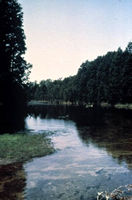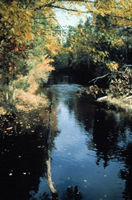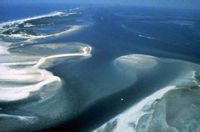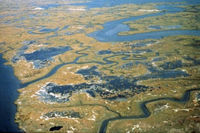Habitats and Communities
The Reserve offers a wide range of different habitats, including: upland pine-oak forests, lowland Atlantic white cedar swamps, freshwater marshes, salt and freshwater tidal marshes, barrier islands (including sandy beaches and dune habitats), shallow bays, and the coastal ocean.
Plants
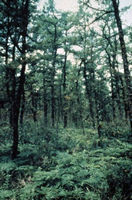 Upland forest areas support two major vegetation types, namely pine-oak forest and oak-pine forests. The dominant tree is the pitch pine (Pinus rigida). In no other region in North America does the pitch pine cover such an extended area. Other abundant species include short-leaf pine and oaks of several species: scrub, blackjack, black, red, white, and chestnut. The most common oak species north of the Mullica River is the black oak; in the south, the scarlet oak becomes prominent. The understory of these forests is a variety of shrubs, mostly of the oak and heath family, such as lowbush blueberry and black huckleberry. Typical ground cover includes lichens, mosses, bracken fern and members of the heath family (bearberry and teaberry).
Upland forest areas support two major vegetation types, namely pine-oak forest and oak-pine forests. The dominant tree is the pitch pine (Pinus rigida). In no other region in North America does the pitch pine cover such an extended area. Other abundant species include short-leaf pine and oaks of several species: scrub, blackjack, black, red, white, and chestnut. The most common oak species north of the Mullica River is the black oak; in the south, the scarlet oak becomes prominent. The understory of these forests is a variety of shrubs, mostly of the oak and heath family, such as lowbush blueberry and black huckleberry. Typical ground cover includes lichens, mosses, bracken fern and members of the heath family (bearberry and teaberry).
Lowland forest areas are composed of Atlantic white cedar, red maple, pitch pine, black gum, Gray birch, sassafras and sweetbay magnolia. Pitch pine lowlands are characterized by a dense canopy of pitch pine, often occurring in depressions and as narrow bands along stream and swamp banks. Secondary trees may include red maple, blackgum and sweet bay magnolia.
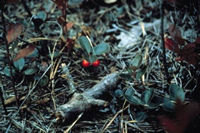 Lowland forest understory growth tends to be more varied than upland growth, with sheep laurel, stagger-bush, dangleberry, black huckleberry, and sweet pepperbush as prominent shrubs. Sheep laurel is especially abundant in these areas, while leather-leaf occupies the margins of standing water. Ground cover layers are also quite diverse and well developed, with bracken ferns, teaberry and moss lichen vegetation. Cedar swamps and sphagnum bogs are scattered throughout the pine lowlands, with the dominant tree being the Atlantic white cedar.
Lowland forest understory growth tends to be more varied than upland growth, with sheep laurel, stagger-bush, dangleberry, black huckleberry, and sweet pepperbush as prominent shrubs. Sheep laurel is especially abundant in these areas, while leather-leaf occupies the margins of standing water. Ground cover layers are also quite diverse and well developed, with bracken ferns, teaberry and moss lichen vegetation. Cedar swamps and sphagnum bogs are scattered throughout the pine lowlands, with the dominant tree being the Atlantic white cedar.
 Salt marshes occur near the coast and along the lower Mullica River, consisting primarily of salt meadow grass (Spartina patens) and saltwater cordgrass (Spartina alterniflora), as well as spike grass (Distichlis spicata). High marsh areas that are flooded less regularly are characterized by salt meadow grass, spike grass, and black grass (Juncus gerardii). Species characteristic found in salt pannes areas include Bigelow's glasswort (Salicornia bigelovii), common glasswort (S. europea), and perennial glasswort (S. virginica), as well as marsh spearscale (Atriplex patula) and annual salt marsh fleabane (Pluchea purpurascenes).
Salt marshes occur near the coast and along the lower Mullica River, consisting primarily of salt meadow grass (Spartina patens) and saltwater cordgrass (Spartina alterniflora), as well as spike grass (Distichlis spicata). High marsh areas that are flooded less regularly are characterized by salt meadow grass, spike grass, and black grass (Juncus gerardii). Species characteristic found in salt pannes areas include Bigelow's glasswort (Salicornia bigelovii), common glasswort (S. europea), and perennial glasswort (S. virginica), as well as marsh spearscale (Atriplex patula) and annual salt marsh fleabane (Pluchea purpurascenes).
Vegetation of the barrier islands include dune grass (Ammophila), which anchors the sand in the foredunes, and a mix of bayberry, heather and marsh elder dominating the back dune. The few freshwater pockets, lying around the islands, are occupied by typical grasses, sedges, and flowering plants.
Animals
 Great Bay is a major migratory stop and wintering area for many waterfowl, shorebirds and raptors. During the winter, the area's waterfowl population is over 70,000 individuals. There are at least 44 distinct water bird nesting colonies for fifteen different species. These include egrets, gulls, terns, and skimmers. Other birds of the Reserve include herons, egrets, ospreys, eagles, owls, hawks, warblers and sparrows.
Great Bay is a major migratory stop and wintering area for many waterfowl, shorebirds and raptors. During the winter, the area's waterfowl population is over 70,000 individuals. There are at least 44 distinct water bird nesting colonies for fifteen different species. These include egrets, gulls, terns, and skimmers. Other birds of the Reserve include herons, egrets, ospreys, eagles, owls, hawks, warblers and sparrows.
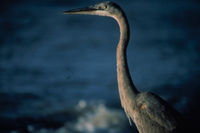 The Mullica River-Great Bay area also supports 61 different species of finfish. Major anadromous fish include striped bass, alewife, and blueback herring which spawn in tributaries. Shellfish populations are also extensive in the form of clams, mussles, and oysters (historically more abundant). Amphibians of the Reserve include the elusive and protected Pine Barrens treefrog, and several other frog and salamander species. A diversity of reptiles are found within the Reserve, represented by a variety of terrestrial and aquatic turtles, and several lizard and snake species, including the northernpine snake and the timber rattlesnake.
The Mullica River-Great Bay area also supports 61 different species of finfish. Major anadromous fish include striped bass, alewife, and blueback herring which spawn in tributaries. Shellfish populations are also extensive in the form of clams, mussles, and oysters (historically more abundant). Amphibians of the Reserve include the elusive and protected Pine Barrens treefrog, and several other frog and salamander species. A diversity of reptiles are found within the Reserve, represented by a variety of terrestrial and aquatic turtles, and several lizard and snake species, including the northernpine snake and the timber rattlesnake.
Endangered Species
 The federally-listed threatened plant, swamp pink (helonias bullata) is found within the Reserve. Several occurrences of the federally-listed threatened plant, Knieskern's beaked-rush (Rhynchospora knieskernii), have also been documented within the Reserve boundaries, as well as the sensitive joint-vetch (Aeschynome), Seabeach Amaranth (Amaranthus pumulis), and American chaffseed (Schwalbea americana), all federally-listed as threatened plants.
The federally-listed threatened plant, swamp pink (helonias bullata) is found within the Reserve. Several occurrences of the federally-listed threatened plant, Knieskern's beaked-rush (Rhynchospora knieskernii), have also been documented within the Reserve boundaries, as well as the sensitive joint-vetch (Aeschynome), Seabeach Amaranth (Amaranthus pumulis), and American chaffseed (Schwalbea americana), all federally-listed as threatened plants.
The piping plover nests within the Reserve's boundary (a federally-listed threatened species), as well as the protected bald eagle and the peregrine falcon. A state endangered reptile, the Timber rattlesnake, and several threatened and endangered sea turtles and other marine mammals also utilize land and waters protected within the Reserve boundaries.
Cultural History
People have been living in the Mullica River - Great Bay region for over 8000 years. Evidence of these pre-historic cultures has been found in over 1000 sites in the Pine Barrens, including over 100 sites along the Mullica River and its tributaries. The people living in the Mullica River - Great Bay area at the time of contact with early settlers were part of a large group known as the Lenni Lenape. These Native Americans became known as the Delawares to the settlers. The Delawares occupied the areas which are now Delaware state, Southeastern Pennsylvania, and all of southern New Jersey. In 1758, the remnant of the Delaware Indians living in New Jersey were placed on a reservation of over 3000 acres, known as Edgepillock or "Brotherton." The reservation was located at the headwaters of the Mullica River at what is now known as Indian Mills, Burlington County. The Delawares were relocated to New York State in 1801 and again later to Oklahoma. The NativeAmericans which originally resided in the Mullica River-Great Bay region were known to be skilled gamehunters and fishers of fin and shellfish.
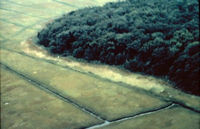 The first settlement of the Mullica River-Great Bay region came in 1697, when Finnish settler Eric Palsson Mullica obtained a piece of land from other settlers in the nearby Swedish settlements along the Delaware River. Most of the early settlers in the region were from Sweden. In the late 1690's several parcels of land were sold within the area that is now Tuckerton. Mullica obtained one of these pieces of land in what is now Lower Bank on the Mullica River. Before the outbreak of the Revolutionary War there were more than 30 homesteads reaching from Tuckerton up the Mullica and Wading Rivers. By 1735, the area consisted of 35 to 40 dwellings. By the mid-18th century, there were sawmills on each of the Mullica River's four stream branches. A dam was built on the Basto River in 1765 and a grist mill and several more sawmills were built in the early 1700's. The first ship to be built in the area was constructed in 1724, marking the beginning of a long ship-building history.
The first settlement of the Mullica River-Great Bay region came in 1697, when Finnish settler Eric Palsson Mullica obtained a piece of land from other settlers in the nearby Swedish settlements along the Delaware River. Most of the early settlers in the region were from Sweden. In the late 1690's several parcels of land were sold within the area that is now Tuckerton. Mullica obtained one of these pieces of land in what is now Lower Bank on the Mullica River. Before the outbreak of the Revolutionary War there were more than 30 homesteads reaching from Tuckerton up the Mullica and Wading Rivers. By 1735, the area consisted of 35 to 40 dwellings. By the mid-18th century, there were sawmills on each of the Mullica River's four stream branches. A dam was built on the Basto River in 1765 and a grist mill and several more sawmills were built in the early 1700's. The first ship to be built in the area was constructed in 1724, marking the beginning of a long ship-building history.
Pirating and privateering trade also began, with ships built in the area being used to raid British ships and for contraband activities. On September 30, 1778, British forces, 400 strong in nine ships, destroyed the fort at Chestnut Neck, but their flagship Zebra with Captain Henry Collins in command, ran aground and had to be abandoned by the British troops. Their plan to continue up the Mullica River and destroy Batsto was abandoned. However, the British Captain and his crew did destroy the small village of Chestnut Neck, killing several men and destroying their storehouse, as well as taking prisoners. The Chestnut Neck Battle Site is on the National Registry of Historic Places.
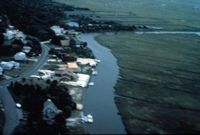 The industrial and commercial ventures along the Mullica River and Great Bay region drew on the natural resources of both the land and water. The river was used to transport goods to the Bay where they were then shipped to New York, Philadelphia and even the West Indies. In addition, iron furnaces were crafted in Batsto and Atsion, that provided the bulk of musket and cannon balls for American troops in the American Revolution and the War of 1812. Beginning in 1814, a glass industry was established in the Pine Barrens. Bottle glass and window glass were both produced in these factories. Two cotton mills were established on the upper reaches of the river system located in Pleasant Mills, in Atsion. One was later converted into a paper mill. Paper mills in the area used native salt hay. Sawmills produced lumber for both housing and shipbuilding throughout the industrial period.
The industrial and commercial ventures along the Mullica River and Great Bay region drew on the natural resources of both the land and water. The river was used to transport goods to the Bay where they were then shipped to New York, Philadelphia and even the West Indies. In addition, iron furnaces were crafted in Batsto and Atsion, that provided the bulk of musket and cannon balls for American troops in the American Revolution and the War of 1812. Beginning in 1814, a glass industry was established in the Pine Barrens. Bottle glass and window glass were both produced in these factories. Two cotton mills were established on the upper reaches of the river system located in Pleasant Mills, in Atsion. One was later converted into a paper mill. Paper mills in the area used native salt hay. Sawmills produced lumber for both housing and shipbuilding throughout the industrial period.
Early horticulture was practiced by the Native Americans when the early settlers arrived. Most of the houses built during the 18th and 19th century were farmsteads. Work was seasonal, with most farming done at the subsistence level. The cranberry industry started in 1835 and is still flourishing today. Cranberry bogs were dug out along the freshwater reaches of the streams that flow into the Mullica River. Blueberries were first cultivated in the Pine Barrens early this century. Fruit and vegetables grown in the area were sent to markets by truck beginning in the mid 1800's.
Tidal Range
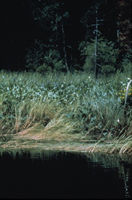 The average tidal range within the coastal portions of the Reserve is approximately 1 meter.
The average tidal range within the coastal portions of the Reserve is approximately 1 meter.
River Flow
Precipitation percolates through the soil into the shallow water table, supporting the region's stream flow as groundwater seepage. All streams found within the Reserve originate as groundwater discharge from the Cohansey Aquifer, a large underground reservoir estimated to hold approximatley 17 trillion gallons of water. No streams flow into or through the Reserve from the outside. Most of the streams have a very low gradient and drain eastward and southward on the Atlantic slope toward the ocean. Rivers, streams, and other bodies of waters in the Reserve are stained brown from the humic and tannic acids of released from decaying vegetation (pine needles and oak leaves), and from a high iron content in the soils. Stream water is acidic, with an average pH of 4.4.
Soil Types
In general, the surface of the coastal plain is a gently rolling terrain, with sandy, droughty soils and few outcrops. The lower component of the region's Kirkwood outcrop consists of very fine, dark, micaceous sand with a pebbly glauconitic basal layer. The upper component is made up of silt and clay. The 2,350 square mile Cohansey formation ranges from the surface to depths of 20 to more than 200 feet. The Cohansey consists of fine to coarse grained quartzose sand with foot-thick lenses of gravel. Generally, clay content is less than 20 percent. The Cohansey and the Kirkwood are the principal aquifers in the region and may contain as much as 17 trillion gallons of water. The tremendous water reserves are a result of the sandy soil, flat terrain, and evenly distributed precipitation.
Geology
The Mullica River-Great Bay Estuary is located on the Atlantic Coastal Plain, created over the last 170-200 million years by depositional and erosional processes. As a result of multiple sea level changes between the last 135 to 5 million years before present, the Atlantic Coastal Plain became overlain with layers of unconsolidated, permeable silts, sands, clays, greensands, and marls. There are at least 15 geologic formations of Cretaceous and Tertiary age strata beneath this coastal plain, beginning with the Raritan formation at the base and ending with the Kirkwood and Cohansey formations on top. The lowest beds originate from continental deposits of the Lower Cretaceous Age. These are overlain by deposits of both continental and marine origin (Upper Cretaceous Age), dating from 65-136 million years before present. All these formations tilt eastward toward the ocean, the Cohansey at the rate of about ten feet per mile. Nearly all of the formations contain fossils of marine animals.

